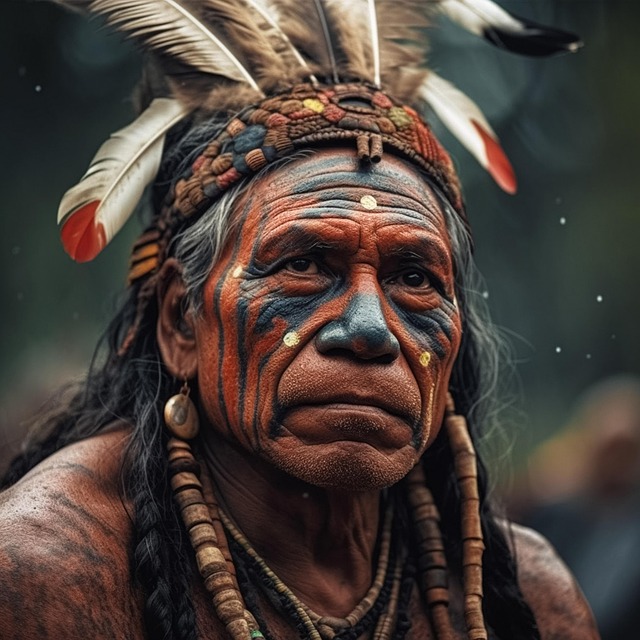Native Americans have deeply influenced the history of Lane County, Oregon, with tribes like Umpqua, Kalapuya, and Yaquina cultivating diverse cultures through ecological knowledge and trade networks. The 19th-century arrival of European settlers brought land disputes and cultural clashes, leading to tribal displacement and a decline in traditional practices. Despite challenges, Native American leaders have protected ancestral territories, fostered cultural resilience, and left lasting legacies. Today, federal initiatives and local efforts aim to reconcile historical injustices, recognize tribal sovereignty, and preserve cultural heritage, with tribal leaders continuing to shape the county's cultural tapestry.
In the rich history of Lane County, Oregon, the presence of Native Americans has left an indelible mark. This article explores the tribal leaders who navigated a landscape shaped by early alliances, challenges, and shifting dynamics with European settlers. From the historical context of Native American communities to the evolution of government-tribal relations, we delve into the lives of notable tribal leaders and their enduring legacy. Discover how these figures have shaped the present-day continuity of tribal leadership in Lane County.
- Historical Context: Native American Presence in Lane County
- Early Tribal Alliances and Communities
- Challenges Faced by Tribal Leaders
- Notable Tribal Leaders and Their Impact
- Government-Tribal Relations Over Time
- Present-Day Legacy and Continuity of Tribal Leadership
Historical Context: Native American Presence in Lane County

Native Americans have a rich and enduring history in what is now known as Lane County, Oregon. For centuries, various tribes, including the Umpqua, Kalapuya, and Yaquina, inhabited this region, fostering diverse cultures and communities. Their presence was characterized by deep connections to the land, intricate knowledge of local ecosystems, and a robust trading network that extended across vast distances. The lush forests, fertile valleys, and abundant coastal resources provided sustenance and shaped their way of life.
The interaction between Native Americans and European settlers in Lane County was complex and often fraught with conflict. As American pioneers entered the region during the 19th century, tensions arose due to land disputes and cultural misunderstandings. This period marked a significant shift as many tribes were displaced from their ancestral homelands, leading to the establishment of reservations and a gradual erosion of traditional ways of life for Native Americans in the area.
Early Tribal Alliances and Communities

In the early history of Native American Lane County, Oregon, several tribes and communities formed alliances based on shared resources, cultural similarities, and mutual protection. These tribal groups, including the Kalapuya, Latini (or Laton), and Yamen (or Yamash), had established themselves along the fertile valleys and scenic riverbanks of what is now known as Lane County. Their societies were intricately woven into the rich landscape, relying on hunting, gathering, and farming for sustenance.
The Native Americans in Lane County fostered strong community bonds and developed intricate trade networks, exchanging goods such as food, tools, and artistic creations. These alliances not only facilitated survival but also enriched their cultural practices and traditions. The Kalapuya, for instance, were known for their advanced agricultural techniques and skilled craftsmanship, while the Latini and Yamen contributed to the region’s diverse knowledge of medicine and spiritual practices. Together, they created a vibrant tapestry of Native American life in Lane County.
Challenges Faced by Tribal Leaders

Tribal leaders in Native American Lane County, Oregon, have historically navigated a complex landscape, facing numerous challenges unique to their communities. One of the primary obstacles was the ongoing struggle for land rights and sovereignty. The arrival of European settlers led to significant dispossession of Indigenous lands, disrupting traditional ways of life and self-governance. Many tribal leaders fought tirelessly to protect their ancestral territories and preserve cultural heritage in the face of encroaching modernization.
Moreover, social and economic disparities have presented substantial hurdles. Tribal communities often grappled with limited access to education, healthcare, and employment opportunities, leading to poverty and marginalization. Despite these challenges, Native American tribal leaders in Lane County have persevered, organizing and advocating for their rights while fostering cultural resilience and community empowerment.
Notable Tribal Leaders and Their Impact

In the rich history of Native American Lane County, several tribal leaders have left an indelible mark with their resilience, wisdom, and unwavering commitment to their communities. One such figure is Chief Channu, a prominent leader of the Yaminite tribe, who played a crucial role in mediating relations between local tribes and European settlers in the 19th century. His diplomatic efforts helped navigate a complex period, ensuring the safety and sovereignty of his people.
Another notable tribal leader was Nancy (also known as Nini) from the Kalapuya tribe. As a powerful healer and spiritual guide, she not only brought healing to her community but also fostered a deep connection with the land. Her knowledge of traditional medicine and cultural practices made her a revered figure, leaving a lasting impact on Native American Lane County heritage.
Government-Tribal Relations Over Time

The relationship between the government and Native American tribes in Lane County, Oregon has evolved significantly over time. Historically, interactions were often marked by conflict and displacement as the U.S. government sought to expand west. Native American lands were seized, and tribal communities were forced into reservations, leading to cultural disruption and loss of traditional ways of life.
However, in recent decades, there has been a growing emphasis on reconciliation and cooperation. Federal initiatives and local efforts have aimed to address historical injustices and foster stronger ties between the government and Native American tribes in Lane County. This shift includes increased recognition of tribal sovereignty, shared decision-making processes, and the preservation of cultural heritage. Such developments are crucial steps towards healing and ensuring a more inclusive future for all residents, including the area’s indigenous communities.
Present-Day Legacy and Continuity of Tribal Leadership

In the contemporary landscape of Lane County, Oregon, the legacy of Native American tribal leaders continues to shape and influence the region’s cultural tapestry. Their enduring impact is evident in the thriving indigenous communities that have persevered despite historical challenges. These tribes, with their rich history and unique traditions, serve as a living bridge between the past and present, fostering cultural continuity.
The leadership within these communities has evolved over time, adapting to modern circumstances while honouring ancestral ways. Today, tribal leaders play pivotal roles in preserving indigenous knowledge, promoting cultural awareness, and advocating for the rights of Native American peoples. Their efforts contribute to a vibrant and resilient indigenous presence in Lane County, ensuring that the stories, languages, and customs of their ancestors remain an integral part of the region’s identity.






